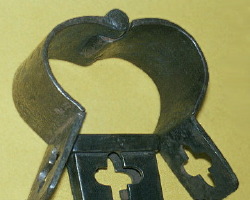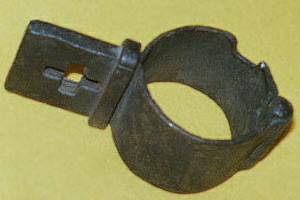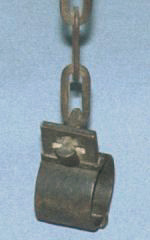|
Hier möchte ich etwas über mittelalterliche Schellen
und allgemeiner auch ein wenig über alte Schellen schreiben.
Wenn es nur um das Aussehen geht, dann kann so ziemlich jeder
Gegenstand darauf getrimmt werden, alt auszusehen. Einfach
ein bißchen Rost oder schwarzer Lack, und natürlich
das Ganze schwer aussehen lassen. Solche Antiquitäten aus
heutiger Zeit sind nicht allzuschwer zu finden.
|
Here I want to tell you a few things about medieval shackles
or more generally, old time shackles. First of all, if one
is only going for the looks, for the innocent eye pretty
much anything could be made looking historic.
Just make it look rusty or black, make it look heavy.
Such this century's vintage items are not that hard to come by.
|
![[ Handeisen ]](grillen11.300x150.jpeg)
|
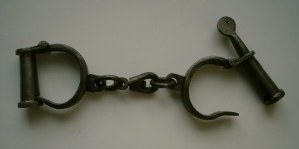
|
|
Aber wenn man genauer hinschaut, merkt man dann schon, daß
Verfahren und Werkzeuge unserer Zeit eingesetzt wurden, und
allermeist hat auch das Design recht wenig mit Mittelalter zu tun.
Echte mittelalterliche Objekte oder selbst Gegenstände aus
dem 17. Jahrhundert, welche jenen noch einigermaßen ähneln,
sind deutlich seltener und sehen oft auch recht schlicht aus.
Das Design kann sogar einfacher sein als römische Schellen.
Blattfederverschlüsse finden sich nicht gerade selten,
und auch Puzzleschellen finden sich schon in prähistorischer Zeit.
|
But once one is looking closer, one usually notices that
tools and methods of our time have been employed in the
manufacturing process, and even the general design differs.
True medieval stuff or even 17th century stuff that is still
reasonably close to its predecessors is harder to find, and
does not look that sophisticated. It may even be inferiour
to the design of Roman manacles and fetters.
Leaf spring locks are quite common in the Roman era, and
puzzle shackles have already been known in prehistoric times.
|
![[ Römische Schellen - Roman Shackles ]](lyon17.300x200.jpeg)
|
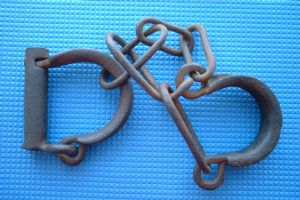
|
|
Zum Mittelalter sollte man sich vergegenwärtigen, daß
Schlösser recht aufwendige und kostbare Gegenstände
waren. Das gilt sowohl für Vorhängeschlösser
als auch für Schellen mit eingebauten Schloß.
Daher versuchte man durchaus, deren Zahl zu reduzieren
oder diese komplett zu vermeiden.
|
For the medieval times one should know that locks, either built
into the shackles, or separate items like padlocks, were quite
sophisticated and thus expensive items. Thus one preference
was to avoid them or minimise their number.
|
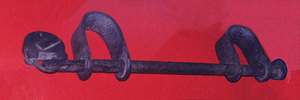
|
![[ Bilbos ]](graven08.300x100.jpeg)
|
|
Sicherlich wurden einige Reife mit Vorhängeschlössern
verschlossen. Aber dann gibt es Prinzipien und Entwürfe
wie ein Schloß für mehrere Schellen oder schlicht
Schellen ohne Schloß. Beim Bilbo geht eine Stange durch
mehrere Schäkel durch. Dann gibt es Kapselschellen, welche
mit einer durchgefädelten Kette verschlossen werden.
Natürlich muß man die Kette sichern...
|
Certainly there have been rings that you closed with a padlock.
But there are designs that do a two-for-one job or simply
avoid the lock at the shackle. One is the bilbo design, very
much like a bar passing through two (or more) maritime-typ
shackles. The other is the Cup Lock Shackle or Cap Lock Shackle,
only requiring a chain to keep it locked. Of course you have to
secure the chain...
|
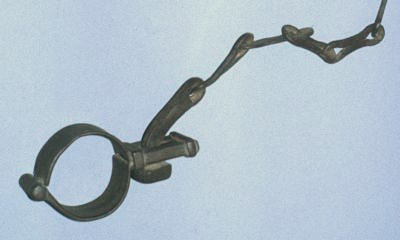
|
|
Mit teuren Schlössern, zudem von einfacherer Bauart
und oft mit einfachen Dietrichen zu Öffnen, sollte es
nicht überrraschen, daß statt eines
Vorhängeschlosses oft ein Ring mit Hammerschlägen
verschlossen wurde. Spezielle Fesseleisen für Nieten
finden sich auch noch in späteren Zeiten.
|
Locks being valuable items, and certainly less pick-proof than
current incarnations, it should be no surprise that sometimes
in place of a padlock a ring might be hammered shut. There are
also dedicated irons that needed to be riveted shut. These
also persist towards later times.
|

|
|
In späteren Zeiten kommen dann Schraubverschlüsse auf,
wo man Werkzeug zum Öffnen und Schließen braucht.
Auch Dinge mit Blattfedern tauchen auf. Irgendwann gibt es dann
die ersten Darbies zum Zuschnappen. Diese sind auch schon mehrere
hundert Jahre alt, im Gegensatz zu ungefähr einem Jahrhundert
für das heute gebrächliche Handschellendesign.
|
Later times see some built-it screw locking mechanisms, where
one needs the tools both for closing and opening. There may
also be leaf spring locking things. Some time later the Darby
mechanism has come up, allowing you to click the shackle shut,
but that is already several centuries old compared to the
modern handcuff design that is - give or take - one century old.
|
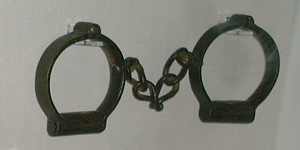
|
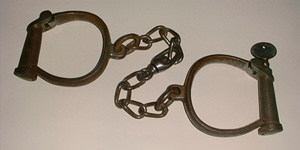
|
|
Aus der amerikanischen Geschichte kennt man zum Beispiel
Sklavenschellen und Eisenkugeln. Auch wenn einiges auf
ätere Modellen basiert, wegen der Qualität und
moderneren industriellen Fertigung sähe jene "Massenware"
für einen mitelalterlichen Betrachter schon recht futuristisch aus.
|
American history yields quite a few items like slave shackles
or ball-and-chain, but although some of them are possibly based
on older designs, the quality and the more modern production
methods used for such "mass-produced" items would have made
them look futuristic to a true medieval person.
|
|
In all diesen Jahren hat sich auch der Einsatzzweck
gewandelt. Handschellen sind schnell angelegt und dienen als
Hilfsmittel bei Verhaftungen, während die Verwendung
von Schellen über längere Zeit nicht mehr so
populär ist.
|
And during all these years gone by the scope of restraints
has changed. Modern handcuffs, rapidly applied, are used
in arrest situations, while long term wearing of metalware
has lost quite some popularity.
|
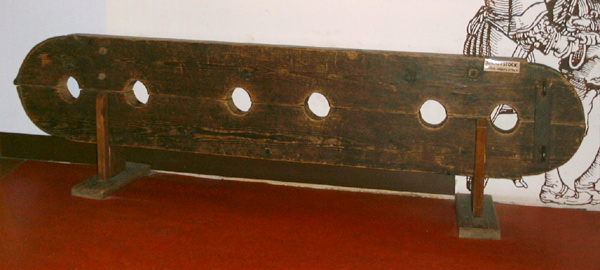
|
|
Zum Schluß sollte man nicht ganz vergessen, daß
in alten Zeiten für Block, Joch und Pranger auch Holz
ein durchaus geeignetes Material war.
|
And let's not forget to mention that in old times
that wood was also quite suitable a material
for stocks, blocks, yokes and pillories.
|
A shackle which does not need a padlock but a chain to lock shut.
You close the shackle, push the cup shaped piece over the
two flat parts, and then pass a chain through the cross-shaped
holes. The chain used may have a block at one end.
Place a lock on the other end.
Then you cannot pull the chain out of the hole, the cup cannot be
taken off the shackle which in turn cannot be opened.
